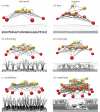How habitat-modifying organisms structure the food web of two coastal ecosystems
- PMID: 26962135
- PMCID: PMC4810843
- DOI: 10.1098/rspb.2015.2326
How habitat-modifying organisms structure the food web of two coastal ecosystems
Abstract
The diversity and structure of ecosystems has been found to depend both on trophic interactions in food webs and on other species interactions such as habitat modification and mutualism that form non-trophic interaction networks. However, quantification of the dependencies between these two main interaction networks has remained elusive. In this study, we assessed how habitat-modifying organisms affect basic food web properties by conducting in-depth empirical investigations of two ecosystems: North American temperate fringing marshes and West African tropical seagrass meadows. Results reveal that habitat-modifying species, through non-trophic facilitation rather than their trophic role, enhance species richness across multiple trophic levels, increase the number of interactions per species (link density), but decrease the realized fraction of all possible links within the food web (connectance). Compared to the trophic role of the most highly connected species, we found this non-trophic effects to be more important for species richness and of more or similar importance for link density and connectance. Our findings demonstrate that food webs can be fundamentally shaped by interactions outside the trophic network, yet intrinsic to the species participating in it. Better integration of non-trophic interactions in food web analyses may therefore strongly contribute to their explanatory and predictive capacity.
Keywords: consumer–resource interactions; ecological networks; ecosystem engineering; facilitation; foundation species; non-trophic interactions.
© 2016 The Author(s).
Figures




References
Publication types
MeSH terms
LinkOut - more resources
Full Text Sources
Other Literature Sources

